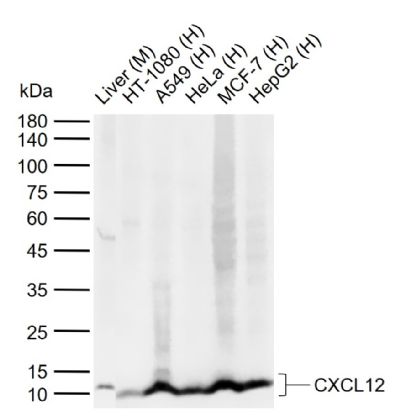[IF=2.65] Narubhorn Ongprakobkul. et al. Effects of local vs systemic administration of CXCR4 inhibitor AMD620 on orthodontic tooth movement in rats. Am J Orthod Dentofac. 2022 Mar;: IHC ; Rat.
[IF=3.404] Yan-Cong Wang. et al. NRSF deficiency leads to abnormal postnatal development of dentate gyrus and impairment of progenitors in subgranular zone of hippocampus. 2021 May 07 IHC ; Mouse.
[IF=2.495] Qi D et al. Stromal cell‐derived factor‐1 regulates the secretion of interleukin‐1β in the temporomandibular joint of rats with synovial inflammation. J Oral Pathol Med. 2020 Oct;49(9):933-939. IHSLCP ; Rat.
[IF=11.75] Grootaert, Mandy OJ, et al. "Defective autophagy in vascular smooth muscle cells accelerates senescence and promotes neointima formation and atherogenesis." Autophagy (2015). WB ; Mouse.
[IF=1.591] Jikai Wang. et al. MFGE8 mitigates brain injury in a rat model of SAH by maintaining vascular endothelial integrity via TIGβ5/PI3K/CXCL12 signaling. 2021 May 15 WB ; Rat.
[IF=3.636] Kawamura Teruhiko. et al. Identification of genes associated with endometrial cell ageing. Mol Hum Reprod. 2021 Feb;27(2): IHC ; Human.
[IF=8.98] Pei, Guangchang, et al. "Renal Interstitial Infiltration and Tertiary Lymphoid Organ Neogenesis in IgA Nephropathy." Clinical Journal of the American Society of Nephrology (2013): CJN-01150113. IHSLCP ; Human.
[IF=1.43] Wang, Xiao-yan, et al. "AMD620 attenuates MMP-3 and MMP-9 expressions and prevents cartilage degradation in a monosodium iodoacetate-induced rat model of temporomandibular osteoarthritis." Journal of Oral and Maxillofacial Surgery (2016). IHSLCP ; Rat.
